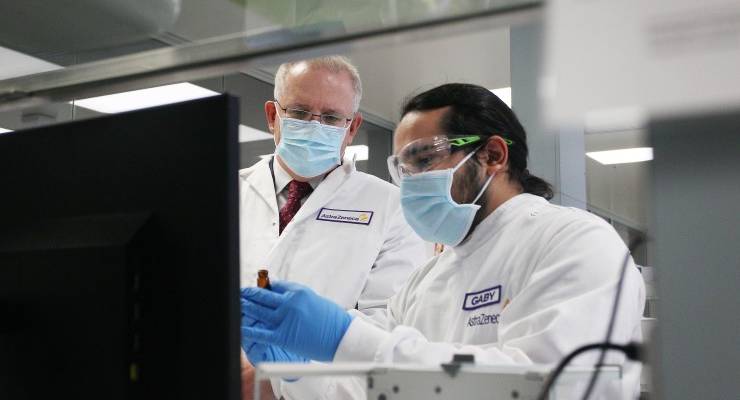
In Both Sides Now, author and ethicist Leslie Cannold presents two sides of an argument. Then it’s over to you: what do you think is true, and what do you think Cannold really believes?
Today: in the face of new COVID-19 variants and supply shortages, is it time to stop relying on foreign companies and start manufacturing our own vaccines in earnest?
Yes: let’s pivot and make our own vaccine that actually works against the new variants. No: Let’s trust the experts and take the jab whenever we’re offered it. They’ve steered us straight so far.
Yes
Australia’s plans to use vaccines to get our economy and lives back to normal were looking shaky long before they fell over entirely at the end of last week when our government joined the rest of the world in advising against giving the two-dose viral vector vaccine from AstraZeneca to anyone under 50 because of a small but potentially serious risk of blood clots.
The age cut-off seems random. In Europe, where the risk of community transmission (and therefore the benefit of vaccination) is much higher, this vaccine will be given only to those aged 55 and above (in France and Belgium) or 60 and older (in Italy, Germany, Spain, the Netherlands, Finland and Sweden).
The AstraZeneca has also been given to younger age groups here and overseas, and older people have come down with the rare blood clot, so medical experts still can’t say for certain that older age reduces the risk of this complication.
Rollout of the Johnson & Johnson jab, also a viral vector vaccine, has just come to a screaming halt in the US, South Africa and Europe too when evidence of the same rare blood clotting event surfaced.
So what should Australia do, given the mess our vaccine program was in even before we belatedly threw in the towel on AstraZeneca (the vaccine had already demonstrated relatively low efficacy rates, which got even worse against the so-called South African variant now making its way across the world)?
With inadequate supplies of vaccines in the country overall and literally no government timetable for when most of us can expect to be vaccinated at all, surely it’s time to press pause and think it out again.
Here’s what I think. If we want to protect our population and open back up to the world, this first generation of vaccines won’t get us there.
While the world’s existing vaccine arsenal may be highly effective at preventing serious disease and death from earlier versions of the virus, it is less — sometimes much less — effective against variants that are quickly becoming the dominant. This includes the B1 variants first identified in the UK, South Africa and California which are now driving what experts fear is — despite very high vaccination rates — the start of yet another wave in the US. The PI variant, meanwhile, first recognised in Japan and Brazil, is now behind serious outbreaks and some reinfections amongst those who’ve already had COVID-19 in Canada and New York.
South Africa understands this, which is why it has halted use of the AstraZeneca and Johnson & Johnson vaccines. They are just too ineffective against the variant that is now the dominant strain. In Israel, where nearly 60% of the population has been vaccinated, is now seeing infections of the South African strain amongst those already fully vaccinated.
But the rest of the world is stuck. With such high rates of community transmission, countries have to keep vaccinating, even with a less-effective vaccine, not just because it reduces death and illness but because the relentless transmission that creates these variants will continue to undermine our defences.
Australia on the other hand has virtually no community transmission. We can pivot. Rather than spend the time and money lining up for a vaccine that will require a “booster” before we are protected from even the variants we have now, we should cut to the chase.
We should be ordering the boosters most vaccine companies are working on now so we can receive these around the same time as our initial shots. Better yet, we could tool up to make the world’s first “multivalent” vaccine ourselves.
A multivalent vaccine — preferably using the mRNA technology that has proved so effective and would serve us well in any pandemic crisis — could be the answer to the shortcomings of existing vaccines. A single or perhaps multiple jabs that will give us strong and sustained immunity against all current variations of the virus: a number that hopefully won’t continue to increase spiral as the rest of the world – where the spread is uncontrolled – reduces the number of mutations through vaccination.
Producing our own multivalent vaccine is the best way for Australia to catch up with the virus and the rest of the world, rather than chasing our tails in a race that’s already been lost. It may also be the only way — as rapidly unfolding events in the US suggest — we can ever safely travel and open up again.
No
Something is better than nothing. Before we knew if we’d have any vaccination for COVID-19, the view was that one that was even 50% effective would be a boon. Now, just a year later when all the vaccines on the market have cleared this hurdle in clinical trials, we’re complaining.
We’ve already had a crack at developing our own vaccine. It didn’t work out. Plus, having watched the slow and painful attempts to re-tool and get up to speed in manufacturing the local supply of AstraZeneca, we simply don’t have time to throw in the towel once more and start again.
Skipping a jab with a first-generation vaccine may not even be possible. The boosters currently being tested around the world are designed to improve the effectiveness of our current inoculations, not replace them.
Vaccine manufacture is a highly complex undertaking and takes time. No one’s got a crystal ball. Even if Australia decided it was third-time lucky and started working today to make a multivalent vaccine, we wouldn’t be ready to start getting shots into arms until next year and, by then, new concerning variants could have emerged. We’ll be back to square one again.
In the meantime we’ll be missing out. Scientists say that our current arsenal of vaccines will turn COVID-19 into the common cold. That means that once a significant percentage of the populations of Europe and the US are fully vaccinated, they’ll open up.
Is Australia seriously proposing to sit that glorious day out, while allowing the sectors that have already suffered the most from the public health response to COVID-19 — arts, tourism and education — to die on the vine?
We don’t have JobKeeper anymore, and the government won’t listen to reason and resurrect it for these sectors. The mental health of too many Australians is fragile — we must do whatever we can, as quickly as possible, to open up.
That means getting vaccinated. With whatever vaccine we are offered as soon as possible. This means people over 50 should be signing up for their AstraZeneca jab as soon as it’s available.
It’s time to stop second-guessing the experts. They’ve got us where we are today and they’ll get us to the end of the pandemic, too. Have faith.
What side are you on? And where do you think Cannold sits? Send your thoughts to letters@crikey.com.au with Both Sides Now in the subject line.








Dump it’s vaccination strategy? The one that involves us making the vaccine ourselves? Like CSL is already doing, in Melbourne?
Neither was the UQ vaccine a failure as far as I understand: it works great. They (the government) just didn’t want the supposed public confusion of occasional false-positive HIV results.
Neither argument here makes any sense. Please stop confusing the issue.
The UQ vaccine showed promising results, and surely it could have been funded to work around the problem with their molecular clamp. And, of course, the UQ vaccine was not the only attempt to develop a vaccine in Australia; one being developed at Flinders University, again with promising results in Phase 1 trials, has received no funding for further development from the government.
Not if Scotty is involved. I was immediately put off when I saw Scotty in the opening image. All I could think of was the vaccine curdling in its container under the spoon bending power of his all knowing, all seeing, emotionally charged gaze bookended by the snarky smirk.
If he cannot order and have vaccines delivered in a timely manner under his management why on earth would he be attempting to have the product made locally under his management.
He has absolutely no self awareness. Perhaps he has been confronted by the smirk in the shaving mirror on too many mornings to have a honest appreciation of what he has to offer the nation apart from prayers, thoughts and the occasional Jen managed exploration of his compassionate inner self.
CSL Ltd was once the Commonwealth-owned Commonwealth Serum Laboratory. Had it remained in public ownership rather than being flogged-off by Keating – a fact we have obviously utterly utterly forgotten – it would have given us what we need more quickly, more cheaply, and more effectively.
Ellen ‘t Hoen, a medical IP expert and campaigner, said wealthy governments around the world had poured billions of taxpayer dollars into developing vaccines that would be ultimately owned and controlled by companies and their shareholders. “The companies raked in billions in public money and are now making the same statements we’ve heard for the past 30 years … that IP is the underpinning of innovation … But the underpinning of innovation for Covid-19 is the massive public financing, and now that public financing is being privatised through the IP system – and that’s something C-Tap could have prevented.”
Governments once owned and ran these things for a reason.